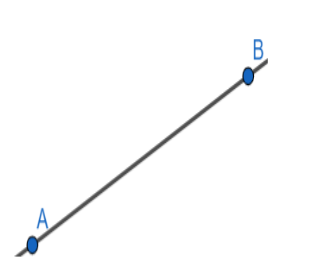
If the points (p,0) , (0,q) and (1,1) are collinear , then \[\dfrac{1}{p}+\dfrac{1}{q}\] is equal to:
\[\begin{align}
& \left( a \right) -1 \\
& \left( b \right) 1 \\
& \left( c \right) 2 \\
& \left( d \right) 0 \\
\end{align}\]
Answer
607.8k+ views
Hint: We can approach this question by first writing the equation of the straight line that passes through two points by using the two point formula and then substituting the other point in the line equation in order to get the relation given in the question.
Complete step-by-step answer:
Firstly, points which lie on the same straight line are called collinear points.
Now in order to check the collinearity we need to first find the equation of the straight line that passes through the two given points.
The equation of straight line passing through two points can be found by using the two point formula.

Let
\[\begin{align}
& A\left( {{x}_{1}},{{y}_{1}} \right) \\
& B\left( {{x}_{2}},{{y}_{2}} \right) \\
\end{align}\]
Now from two point formula equation of straight line passing through A and B is
\[\frac{x-{{x}_{1}}}{{{x}_{2}}-{{x}_{1}}}=\frac{y-{{y}_{1}}}{{{y}_{2}}-{{y}_{1}}}............\left( 1 \right)\]
Given points are (p,0), (0,q) now on comparing these with the points \[A\left( {{x}_{1}},{{y}_{1}} \right)\]and \[B\left( {{x}_{2}},{{y}_{2}} \right)\].
We get:
\[\begin{align}
& {{x}_{1}}=p,{{y}_{1}}=0 \\
& {{x}_{2}}=0,{{y}_{2}}=q \\
\end{align}\]
Now on substituting these values in the two point formula from the equation (1) we get,
\[\begin{align}
& \Rightarrow \dfrac{x-{{x}_{1}}}{{{x}_{2}}-{{x}_{1}}}=\dfrac{y-{{y}_{1}}}{{{y}_{2}}-{{y}_{1}}} \\
& \Rightarrow \dfrac{x-p}{0-p}=\dfrac{y-0}{q-0} \\
\end{align}\]
Now by simplifying it we get,
\[\Rightarrow \dfrac{x-p}{-p}=\dfrac{y}{q}\]
Now by simplifying the terms on both the sides we can write it as:
\[\Rightarrow \dfrac{-x}{p}+1=\dfrac{y}{q}\]
Then bring the x and y terms to one side and keep constant terms on the other side we get,
\[\Rightarrow \dfrac{x}{p}+\dfrac{y}{q}=1................\left( 2 \right)\]
Hence, the equation of line passing through (p,0) and (0,q) is \[\dfrac{x}{p}+\dfrac{y}{q}=1\].
Now as (p,0) and (0,q) and (1,1) are collinear that means they lie on the same straight line which implies that the point (1,1) lies on the line \[\dfrac{x}{p}+\dfrac{y}{q}=1.\]
A point is said to lie on the line when it satisfies the equation of the given line.
So, now by substituting (1,1) in the equation \[\dfrac{x}{p}+\dfrac{y}{q}=1.\]we get,
\[\therefore \dfrac{1}{p}+\dfrac{1}{q}=1\]
Hence option (b) is correct.
Note- The equation of the straight line can also be found by using the slope point method but here it is ideal to use the two point method because in the question they already gave all the points required to apply that formula. However, both the methods will give the same result.
While writing the equation of the line if we cross multiply it, it will be little confusing to reach to the conclusion of \[\dfrac{1}{p}+\dfrac{1}{q}\]. So, it is better to simplify by dividing it with p on the left hand side there itself.
Complete step-by-step answer:
Firstly, points which lie on the same straight line are called collinear points.
Now in order to check the collinearity we need to first find the equation of the straight line that passes through the two given points.
The equation of straight line passing through two points can be found by using the two point formula.

Let
\[\begin{align}
& A\left( {{x}_{1}},{{y}_{1}} \right) \\
& B\left( {{x}_{2}},{{y}_{2}} \right) \\
\end{align}\]
Now from two point formula equation of straight line passing through A and B is
\[\frac{x-{{x}_{1}}}{{{x}_{2}}-{{x}_{1}}}=\frac{y-{{y}_{1}}}{{{y}_{2}}-{{y}_{1}}}............\left( 1 \right)\]
Given points are (p,0), (0,q) now on comparing these with the points \[A\left( {{x}_{1}},{{y}_{1}} \right)\]and \[B\left( {{x}_{2}},{{y}_{2}} \right)\].
We get:
\[\begin{align}
& {{x}_{1}}=p,{{y}_{1}}=0 \\
& {{x}_{2}}=0,{{y}_{2}}=q \\
\end{align}\]
Now on substituting these values in the two point formula from the equation (1) we get,
\[\begin{align}
& \Rightarrow \dfrac{x-{{x}_{1}}}{{{x}_{2}}-{{x}_{1}}}=\dfrac{y-{{y}_{1}}}{{{y}_{2}}-{{y}_{1}}} \\
& \Rightarrow \dfrac{x-p}{0-p}=\dfrac{y-0}{q-0} \\
\end{align}\]
Now by simplifying it we get,
\[\Rightarrow \dfrac{x-p}{-p}=\dfrac{y}{q}\]
Now by simplifying the terms on both the sides we can write it as:
\[\Rightarrow \dfrac{-x}{p}+1=\dfrac{y}{q}\]
Then bring the x and y terms to one side and keep constant terms on the other side we get,
\[\Rightarrow \dfrac{x}{p}+\dfrac{y}{q}=1................\left( 2 \right)\]
Hence, the equation of line passing through (p,0) and (0,q) is \[\dfrac{x}{p}+\dfrac{y}{q}=1\].
Now as (p,0) and (0,q) and (1,1) are collinear that means they lie on the same straight line which implies that the point (1,1) lies on the line \[\dfrac{x}{p}+\dfrac{y}{q}=1.\]
A point is said to lie on the line when it satisfies the equation of the given line.
So, now by substituting (1,1) in the equation \[\dfrac{x}{p}+\dfrac{y}{q}=1.\]we get,
\[\therefore \dfrac{1}{p}+\dfrac{1}{q}=1\]
Hence option (b) is correct.
Note- The equation of the straight line can also be found by using the slope point method but here it is ideal to use the two point method because in the question they already gave all the points required to apply that formula. However, both the methods will give the same result.
While writing the equation of the line if we cross multiply it, it will be little confusing to reach to the conclusion of \[\dfrac{1}{p}+\dfrac{1}{q}\]. So, it is better to simplify by dividing it with p on the left hand side there itself.
Recently Updated Pages
Master Class 11 Economics: Engaging Questions & Answers for Success

Master Class 11 English: Engaging Questions & Answers for Success

Master Class 11 Social Science: Engaging Questions & Answers for Success

Master Class 11 Biology: Engaging Questions & Answers for Success

Class 11 Question and Answer - Your Ultimate Solutions Guide

Master Class 11 Business Studies: Engaging Questions & Answers for Success

Trending doubts
What is meant by exothermic and endothermic reactions class 11 chemistry CBSE

10 examples of friction in our daily life

One Metric ton is equal to kg A 10000 B 1000 C 100 class 11 physics CBSE

Difference Between Prokaryotic Cells and Eukaryotic Cells

What are Quantum numbers Explain the quantum number class 11 chemistry CBSE

1 Quintal is equal to a 110 kg b 10 kg c 100kg d 1000 class 11 physics CBSE




